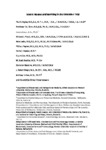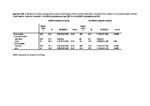Severe Nausea and Vomiting in the Evaluation of Nitrous Oxide in the Gas Mixture for Anesthesia II Trial
| dc.contributor.author | Myles, PS | |
| dc.contributor.author | Chan, MTV | |
| dc.contributor.author | Kasza, J | |
| dc.contributor.author | Paech, MJ | |
| dc.contributor.author | Leslie, K | |
| dc.contributor.author | Peyton, PJ | |
| dc.contributor.author | (& 4 others), | |
| dc.contributor.author | Sneyd, John | |
| dc.contributor.author | Forbes, A | |
| dc.date.accessioned | 2016-04-05T10:46:10Z | |
| dc.date.available | 2016-04-05T10:46:10Z | |
| dc.date.issued | 2016-05-02 | |
| dc.identifier.issn | 0003-3022 | |
| dc.identifier.issn | 1528-1175 | |
| dc.identifier.uri | http://hdl.handle.net/10026.1/4473 | |
| dc.description | File replaced (incorrect version) on 28/7/2022 by KT (LDS). | |
| dc.description.abstract |
<jats:title>Abstract</jats:title><jats:sec><jats:title>Background</jats:title><jats:p>The Evaluation of Nitrous oxide in the Gas Mixture for Anesthesia II trial randomly assigned 7,112 noncardiac surgery patients to a nitrous oxide or nitrous oxide–free anesthetic; severe postoperative nausea and vomiting (PONV) was a prespecified secondary end point. Thus, the authors evaluated the association between nitrous oxide, severe PONV, and effectiveness of PONV prophylaxis in this setting.</jats:p></jats:sec><jats:sec><jats:title>Methods</jats:title><jats:p>Univariate and multivariate analyses of patient, surgical, and other perioperative characteristics were used to identify the risk factors for severe PONV and to measure the impact of severe PONV on patient outcomes.</jats:p></jats:sec><jats:sec><jats:title>Results</jats:title><jats:p>Avoiding nitrous oxide reduced the risk of severe PONV (11 vs. 15%; risk ratio [RR], 0.74 [95% CI, 0.63 to 0.84]; P &lt; 0.001), with a stronger effect in Asian patients (RR, 0.55 [95% CI, 0.43 to 0.69]; interaction P = 0.004) but lower effect in those who received PONV prophylaxis (RR, 0.89 [95% CI, 0.76 to 1.05]; P = 0.18). Gastrointestinal surgery was associated with an increased risk of severe PONV when compared with most other types of surgery (P &lt; 0.001). Patients with severe PONV had lower quality of recovery scores (10.4 [95% CI, 10.2 to 10.7] vs. 13.1 [95% CI, 13.0 to 13.2], P &lt; 0.0005); severe PONV was associated with postoperative fever (15 vs. 20%, P = 0.001). Patients with severe PONV had a longer hospital stay (adjusted hazard ratio, 1.14 [95% CI, 1.05 to 1.23], P = 0.002).</jats:p></jats:sec><jats:sec><jats:title>Conclusions</jats:title><jats:p>The increased risk of PONV with nitrous oxide is near eliminated by antiemetic prophylaxis. Severe PONV, which is seen in more than 10% of patients, is associated with postoperative fever, poor quality of recovery, and prolonged hospitalization.</jats:p></jats:sec> | |
| dc.format.extent | 1032-1040 | |
| dc.format.medium | ||
| dc.language | en | |
| dc.language.iso | en | |
| dc.publisher | Ovid Technologies (Wolters Kluwer Health) | |
| dc.subject | Aged | |
| dc.subject | Anesthesia Recovery Period | |
| dc.subject | Anesthesia, Inhalation | |
| dc.subject | Anesthetics, Inhalation | |
| dc.subject | Antiemetics | |
| dc.subject | Asian People | |
| dc.subject | Digestive System Surgical Procedures | |
| dc.subject | Endpoint Determination | |
| dc.subject | Female | |
| dc.subject | Fever | |
| dc.subject | Humans | |
| dc.subject | Kaplan-Meier Estimate | |
| dc.subject | Longevity | |
| dc.subject | Male | |
| dc.subject | Middle Aged | |
| dc.subject | Nitrous Oxide | |
| dc.subject | Postoperative Complications | |
| dc.subject | Postoperative Nausea and Vomiting | |
| dc.subject | Risk Factors | |
| dc.subject | Treatment Outcome | |
| dc.subject | White People | |
| dc.title | Severe Nausea and Vomiting in the Evaluation of Nitrous Oxide in the Gas Mixture for Anesthesia II Trial | |
| dc.type | journal-article | |
| dc.type | Journal Article | |
| dc.type | Randomized Controlled Trial | |
| dc.type | Research Support, Non-U.S. Gov't | |
| plymouth.author-url | https://www.webofscience.com/api/gateway?GWVersion=2&SrcApp=PARTNER_APP&SrcAuth=LinksAMR&KeyUT=WOS:000374882700011&DestLinkType=FullRecord&DestApp=ALL_WOS&UsrCustomerID=11bb513d99f797142bcfeffcc58ea008 | |
| plymouth.issue | 5 | |
| plymouth.volume | 124 | |
| plymouth.publication-status | Published | |
| plymouth.journal | Anesthesiology | |
| dc.identifier.doi | 10.1097/ALN.0000000000001057 | |
| plymouth.organisational-group | /Plymouth | |
| plymouth.organisational-group | /Plymouth/Faculty of Health | |
| plymouth.organisational-group | /Plymouth/Users by role | |
| dc.publisher.place | United States | |
| dcterms.dateAccepted | 2016-03-01 | |
| dc.rights.embargodate | 2016-5-2 | |
| dc.identifier.eissn | 1528-1175 | |
| dc.rights.embargoperiod | Not known | |
| rioxxterms.versionofrecord | 10.1097/ALN.0000000000001057 | |
| rioxxterms.licenseref.uri | http://www.rioxx.net/licenses/all-rights-reserved | |
| rioxxterms.licenseref.startdate | 2016-05-02 | |
| rioxxterms.type | Journal Article/Review |



